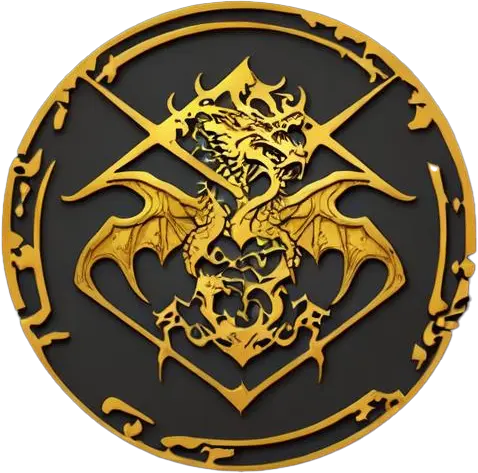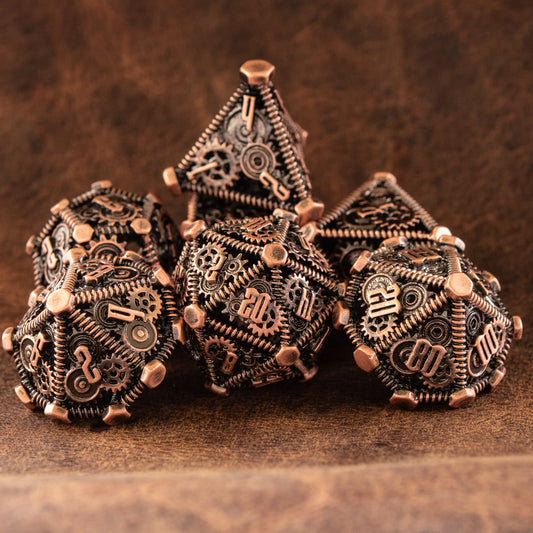
DnD Dice Explained
Share
Dungeons & Dragons (D&D) is a game built on imagination, storytelling, and chance. At the heart of this iconic game is a set of polyhedral dice, each uniquely designed to determine the outcomes of character actions. From launching devastating attacks to avoiding traps or discovering hidden treasures, dice rolls shape the narrative and strategy of the game.
In this article, we’ll dive deep into everything you need to know about DnD dice: their types, how they are used, and the ways they contribute to the overall game experience.
The Role of Dice in Dungeons & Dragons
In D&D, dice rolls determine success or failure for virtually every action. When you attempt to do something significant—like attacking a monster, sneaking past a guard, or casting a spell—you roll dice to determine the outcome. This mechanic introduces an element of randomness to the game, ensuring that even the most skilled player can face surprising challenges.
The dice reflect a character's abilities (such as Strength or Intelligence), modified by bonuses or penalties, to achieve a target number or difficulty set by the Dungeon Master (DM). For instance, when attacking a creature, your roll determines whether you hit, while another roll determines how much damage you deal.
In combat, exploration, and role-playing interactions, dice shape the story and can lead to unexpected outcomes. This randomness is what keeps D&D exciting, as even the most carefully laid plans can succeed or fail based on a simple dice roll.
The Standard DnD Dice Set
A standard DnD dice set includes seven dice, each serving a different purpose in the game. Let’s break down these dice and explore how they are used during gameplay:
-
D4 (Four-sided die): Often referred to as a "caltrop" due to its pyramid shape, the D4 is typically used to determine small amounts of damage or healing. For example, if your character wields a dagger, a successful attack will deal 1d4 points of damage. Similarly, spells like Magic Missile or Cure Wounds can deal or restore hit points based on a D4 roll. It’s a low-range die, used when finer granularity is needed.
-
D6 (Six-sided die): The D6 is one of the most frequently rolled dice in D&D. It's used for a wide range of weapons (short swords, maces, and crossbows) and spells. Rolling a D6 can also determine random events, such as the number of enemies in a room or the number of turns a spell effect lasts. In character creation, D6s are often rolled in multiples to determine your starting attributes, such as Strength, Dexterity, and Wisdom.
-
D8 (Eight-sided die): The D8 is a versatile die that frequently comes into play for mid-level weapon damage. It’s used when wielding martial weapons such as longswords, battleaxes, and some ranged weapons like longbows. Additionally, many healing spells rely on a D8 to determine the amount of hit points restored. Paladins often roll D8s when delivering their powerful smite attacks.
-
D10 (Ten-sided die): The D10 is frequently used for larger attacks, such as those involving spells like Fireball or higher-level weapons like halberds and greatswords. When rolled in pairs (one marked in tens and the other in ones), two D10s can generate a percentage result between 1 and 100, often used for determining success rates in certain scenarios, such as landing a rare critical strike or finding a special item.
-
D12 (Twelve-sided die): The D12 is generally reserved for dealing large amounts of damage. It’s rolled for heavy weapons like greataxes, often wielded by characters like barbarians. While the D12 doesn’t see as much use as the D8 or D10, when it does appear, it usually signals something significant happening, such as a devastating blow during combat.
-
D20 (Twenty-sided die): The D20 is the iconic die of D&D, central to most game mechanics. This die is used for attack rolls, saving throws, skill checks, and determining initiative (the order in which players and monsters take turns during combat). The D20 roll determines the success or failure of most actions in the game, with higher rolls typically representing better outcomes. For example, a roll of 15 or higher may mean you succeed at climbing a wall, while a roll of 5 might mean you fall.
-
Percentile Dice (Two D10s): Percentile dice (also called D100 rolls) are used when determining random outcomes, such as treasure rolls, chances of wandering monsters, or for certain spells and class features. The first D10 represents tens, and the second represents ones, forming a result between 1 and 100. A roll of 00 on both dice counts as 100, the highest possible result.
Dice Rolling Terminology
To understand how dice work in D&D, it’s essential to grasp the terminology used by players and Dungeon Masters alike:
-
1d6: This means you roll one six-sided die and use the result. The number before the "d" tells you how many dice to roll, while the number after it indicates the type of die. So, 3d6 means you roll three six-sided dice and sum the results.
-
Natural 20 (Nat 20): A roll of 20 on a D20, also called a "critical success." In combat, this can mean extra damage, while in skill checks, it often means succeeding spectacularly at a task.
-
Natural 1 (Nat 1): A roll of 1 on a D20, commonly referred to as a "critical failure." In combat, this may mean missing your target completely or even suffering a mishap.
How Dice Are Used in D&D
Now that we know the types of dice, let’s explore how they’re used in Dungeons & Dragons. Dice are essential in several core areas of the game, including combat, skill checks, and saving throws.
Combat and Attack Rolls
Combat is a staple of most D&D campaigns, and the D20 is used to determine whether an attack hits or misses. This is known as an attack roll.
-
Making an Attack Roll: When a player declares an attack, they roll a D20 and add their attack bonus (determined by their character's abilities and proficiency). The result is compared to the target's Armor Class (AC). If the total equals or exceeds the AC, the attack hits. If it falls short, the attack misses.
-
Damage Rolls: If the attack hits, the player rolls the appropriate die to determine how much damage the target takes. Different weapons and spells use different dice. For instance, a longsword might deal 1d8 damage, while a fireball spell deals 8d6 damage. After rolling, the result is often modified by additional bonuses, such as a character's Strength or Dexterity modifier.
-
Critical Hits and Failures: Rolling a natural 20 (a 20 on a D20 without modifiers) results in a critical hit, meaning the player rolls additional dice to deal more damage. On the flip side, rolling a natural 1 often results in a critical failure, potentially leading to negative consequences, like a weapon jamming or hitting an ally by mistake.
Skill Checks and Ability Rolls
In D&D, characters frequently attempt actions that are resolved using skill checks. These actions range from attempting to pick a lock to persuading an NPC or climbing a cliff.
-
Skill Checks: To determine success, a player rolls a D20 and adds their proficiency bonus (if they are skilled in that area) and their relevant ability modifier (like Dexterity or Charisma). The Dungeon Master sets a Difficulty Class (DC) that the player must meet or exceed to succeed. For example, to successfully pick a lock, the player might need to roll higher than a DC of 15.
-
Ability Rolls: Occasionally, a DM might ask for a straight ability roll. This typically happens when a character attempts something not directly tied to a skill, such as lifting a heavy boulder (Strength) or solving a puzzle (Intelligence).
Saving Throws
Saving throws are a character's last line of defense when avoiding danger. They are reactive rolls that occur when a character is trying to resist an effect, such as avoiding a dragon's breath or shaking off a paralysis spell. To make a saving throw, a player rolls a D20 and adds their saving throw modifier (which is based on their character’s ability scores). Success or failure is determined by whether the roll meets or exceeds the DC set by the threat they’re facing.
Specialty DnD Dice
Beyond the basic polyhedral dice, there are various specialty dice that players can use to enhance their game. These dice come in different materials, designs, and configurations, each offering a unique feel or aesthetic. Some of the most popular specialty dice include:
Gemstone Dice
Gemstone dice are crafted from semi-precious stones such as quartz, obsidian, or amethyst. These dice are often heavier than standard resin or plastic dice and offer a luxurious rolling experience. Their uniqueness and beauty make them highly collectible, but they can be more fragile than metal or resin dice.
Metal Dice
Metal dice are known for their weight and durability. Typically made from materials like zinc alloy or brass, these dice provide a satisfying tactile feedback when rolled. Metal dice are particularly popular among players who enjoy the drama and physicality of rolling a heavier die during critical moments of the game.
Fidget Spinner Dice
Combining functionality and fun, fidget spinner dice integrate rotatable spinners into their design, often making them a conversation piece at the game table. While less traditional, these dice add an element of entertainment and flair, especially during downtime between rolls.
Conclusion
In Dungeons & Dragons, dice are more than just tools for determining random numbers—they are central to the game’s mechanics and storytelling. Whether you’re dealing a final blow to a dragon or attempting a daring escape from a dungeon, the roll of the dice can turn the tide in unexpected ways. Whether you use resin dice, metal dice, or gemstone dice, every roll adds to the excitement and unpredictability that makes D&D such an engaging and immersive experience.



